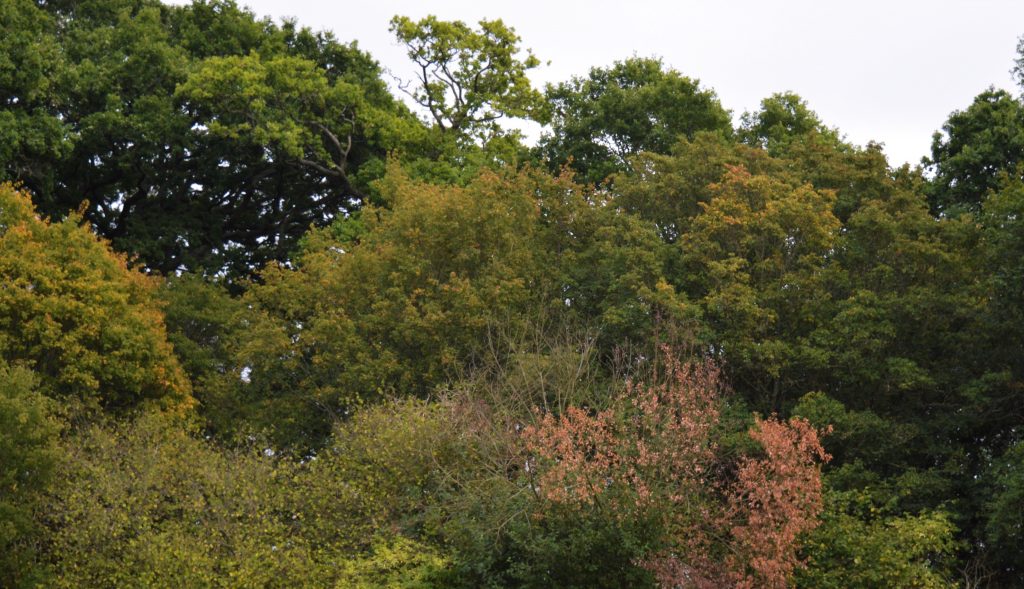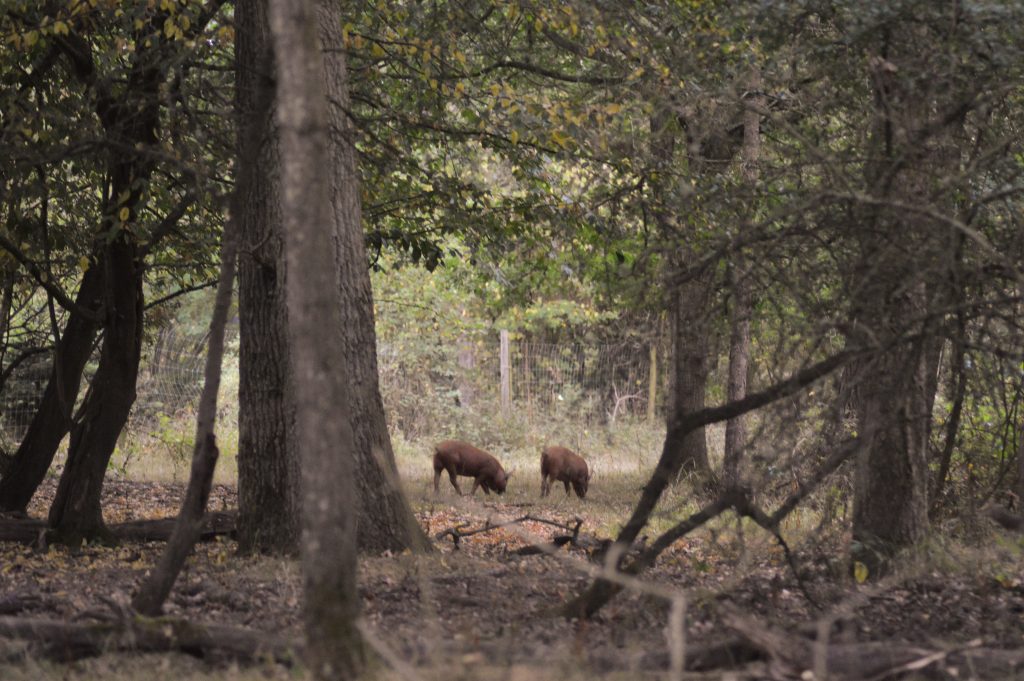Carbon dioxide (CO2) cycles naturally between the atmosphere and the biosphere as a result of natural processes including photosynthesis, respiration, decomposition and combustion. Carbon dioxide is absorbed by organisms in water and on land, creating significant carbon “stores” in biomass and soil.
Human interference has led to an imbalance of the CO2 exchange, and also disrupted existing natural carbon “stocks” through destruction of natural ecosystems (e.g. deforestation, desertification), that has led to a significant amount of CO2 to be released back into the atmosphere.
By restoring habitats, such as wetlands or woodland, we can actively create carbon sinks that sequester carbon in the long-term as carbon is captured within biomass and underground.
Restoring land brings many further benefits (weather protection, greater resilience to climate change, improved biodiversity), but this article will only focus on the potential of carbon sequestration in different land types, and discuss our approach to rewilding with carbon sequestration in mind.
- Carbon sequestration: The process of increasing the carbon content of a carbon reservoir other than the atmosphere. Biological approaches to sequestration include direct removal of carbon dioxide from the atmosphere through land use change, afforestation, reforestation, and practices that enhance soil carbon in agriculture.
- Carbon sink: Any process, activity or mechanism that removes a greenhouse gas or a precursor of a greenhouse gas from the atmosphere.
- Carbon source: Any process, activity, or mechanism that releases a greenhouse gas or a precursor of a greenhouse gas into the atmosphere.
- Carbon stock: The absolute quantity of substance of concern (for example, carbon or a greenhouse gas) held within a reservoir at a specified time. A reservoir is a component of the climate system, other than the atmosphere, which has the capacity to store, accumulate, or release a substance of concern. Oceans, soils, and forests are examples of reservoirs of carbon.
Carbon in Soil
As described in a previous post, soil holds great benefits to our environment through effective carbon sequestration, improving the resilience of our land, and underpinning the diversity of our wildlife.
The 2007 countryside survey estimated that there is 795 Mt C in topsoil in England. This only covers the top 15cm of soil, and therefore does not include carbon stored deeper, which there is undoubtedly extensive carbons stocks deeper underground, particularly in peatlands. It has also been measured that carbon stocks vary by a factor of almost 300, meaning some soil was recorded as almost lifeless in comparison to healthy land. It is estimated that an additional 220 – 730 Mt C could be sequestered in topsoil, if practices were optimised across all land (2).
Soil carbon is essential to take into account in evaluating decisions about rewilding activities or the repurposing of land. For example, afforestation of open grasslands and arable land may increase the carbon in the soil, but the same would not be true of plantations on peaty soils. As a result of afforestation, peat-based soil may dry out, leading to the release of large amounts of carbon into the atmosphere. Therefore, land needs to be carefully studied before approaching with rewilding activities.
Grasslands
Only a small minority of grassland in the UK is considered semi-natural, but even grasslands that are used for agricultural purposes have the potential to store large quantities of carbon. However, various practices to manage the grassland (i.e. prevent large vegetation from growing) and species composition can mean that carbon stores in the land-type can vary greatly. Studies in the United States have shown that high biodiversity grasslands can store 6 times the amount of carbon compared to low diversity grassland (3).
Heathlands
Heathlands in the UK they are roughly divided into Upland and Lowland heathlands at about 300 m of altitude. Most heathlands are a product of centuries of human use and management, and have characteristically nutrient poor. Their carbon stocks are largely held in the soil, as there is little vegetation growth above ground. Transforming arable land into healthland may result in improved carbon sequestration in soil and vegetation, but various considerations about the specific section of lands needs to be taken into account.
Woodland
Woodland has arguable been the land type that has seen greatest transformation through human history. Currently approximately 13% of land in Great Britain is wooded, and only 1.2% is ancient semi-natural woodland, a unique and irreplaceable natural resource.
Transformation of land for agriculture has led to the sparsity of woodland that we see today, with the Forestry commission being only set up after World War 1 to kickstart reforestation when woodland cover was at its minimal level (5%). Since then, various programmes and restoration projects have been undertaken to slowly grow new forests and expand existing woodland regions.
Woodland makes an important contribution to carbon sequestration. As new trees grow, they sequester carbon in their bodies throughout their lifetime. But importantly, they also shelter a broader woodland ecosystem, that continuously feeds the soil with organic matter adding to further carbon storage.
Ancient forest often doesn’t receive the same attention as new planting schemes, as it is often considered that woodland reaches an equilibrium, effectively “max-ing” out its capacity to sequester carbon. However, recent study has shown that the carbon sequestration process in woodland continues in the very long term, and ancient woodland continues to sequester carbon within soil for up to 800 years (4), meaning that recently planted forests will continue to capture carbon to mitigate climate change for centuries if suitably protected.
It is estimated that carbon in soil makes up 75% of the total carbon sequestration in woodland, and there is an estimated total carbon stocks in forest soils in Great Britain of 664 Mt C in the top 1 metre of soil (5).

Wetlands
Wetlands cover a broad range of habitats, including areas of marsh, fen, peatland, with water that is static or flowing, fresh, brackish or salt, including areas of marine water the depth of which at low tide does not exceed six metres. Therefore, wetlands cover a broad range of habitats and landscapes. They all share the feature of being very wet (!), but can also be entirely different and each with their own unique wildlife and capacity for carbon sequestration.
Wetlands are globally considered a vital terrestrial carbon sink, as they exceed the carbon storage capacity of rainforest, woodland and other land types by a significant margin.
Carbon sequestration is most significant in wetlands where vegetation is characterised by Hydrophytes (plants which grow in or on water). Whereas plants on land eventually perish and decompose (with their carbon being released back into atmosphere), wetland plant matter will sink to the bottom of the water bed, preventing decomposition of driving the formation of peat.
Wetlands are amongst the most degraded of all habitats globally, and this is no different in Great Britain. Wetlands were once extensive, however drainage, agricultural expansion, and urban development have led to the decimation of the habitat. According to the Wetland Vision Partnership, 44% of lowland raised bogs have been drained, and 75% ponds have declined in the last 150 years (7). The loss of this land type has arguably been one of the greatest sources of greenhouse gas emissions in recent history.
Rewilding and Carbon Sequestration
The restoration of low-diversity and low-carbon lands to rich habitats offers huge benefits to the environment through carbon sequestration in the fight against climate change.
The greatest impact will be made on lands which have been depleted of their existing carbon stocks through prior management. One analysis of 74 publications found that carbon stocks improved the most by afforestation on land previously used for agriculture, with an improvement of 53% of organic carbon stocks (8).
Nature England has also shared data on improved levels of carbon stocks, illustrated in the table below, whereby carbon stocks of soil (to relatively shallow depth) and vegetation is measured in established land types.

A Nature England survey has measured average soil and vegetation carbon stock levels, which provides a good indicator in predicting how land will improve when restored (see Table 1). The greatest impact will be made to land types whose carbon levels have been depleted to low levels, which is where we will focus our land restoration projects to make the greatest difference.
Table 1: Carbon Stock estimates by habitat type, t C / hectare – tonnes of Carbon per hectare (1)
| Habitat | Carbon stock in soil (t C / ha) | Carbon stock in vegetation (t C / ha) |
| Fen, Marsh and Swamp | 76 | – |
| Bog | 74 | 2 |
| Coniferous Woodland | 70 | 70 |
| Broad leaf, mixed and yew woodland | 63 | 70 |
| Neutral grassland | 60 | 1 |
| Arable and horticulture | 43 | 1 |
It is important to recognise that all land is different, and will recover in different ways. Land restoration is not a quick process, but by measuring the change of the landscape, biodiversity and makeup of soil and vegetation, we can observe the carbon capture over time.
Rewilding and Carbon Sequestration
Different landscape restoration approaches can have varying impacts on biodiversity depending on their objectives, methods, and the specific context in which they are implemented. There are various considerations to ensuring a landscape is not only climate positive, but also nature positive:
- Ecological Connectivity: Restoration efforts that focus on creating or enhancing ecological connectivity between fragmented habitats can have a positive impact on biodiversity. By establishing corridors or stepping stones for species movement, these initiatives enable gene flow, enhance species dispersal, and promote species resilience.
- Habitat Restoration: Targeted restoration of specific habitats, such as forests, wetlands, or grasslands, can directly benefit biodiversity. By restoring natural habitats and their associated ecological processes, including soil health and hydrological cycles, it becomes possible to support the return of native plant and animal species, which in turn fosters biodiversity.
- Ecosystem Services: Landscape restoration can enhance ecosystem services, such as pollination, soil fertility, and water purification, which indirectly benefit biodiversity. By restoring ecosystem functions, it becomes possible to support the diverse array of species that rely on these services for survival and reproduction.
- Climate Change Adaptation: Landscape restoration can play a vital role in climate change adaptation by creating resilient ecosystems. Restoring natural habitats, implementing sustainable land management practices, and promoting native species diversity can increase ecosystem resilience to climate change impacts and support the survival of a wider range of species.
As with Carbon stocks, it is vital to monitor biodiversity to ensure the actions you are taking are making a positive impact on nature. If you are interested in learning more about Biodiversity Monitoring, check out information about our services here, or get in touch.
- Alonso, I., et al., Carbon storage by habitat: Review of the evidence of the impacts of management decisions and condition of carbon stores and sources, Nature England (2012)
- P.M., Chamberlain, et al., No change in topsoil carbon levels of Great Britain, 1978–2007, Biogeosciences (2010)
- Fornara, D.A., Tilman, D. Plant functional composition influences rates of soil carbon and nitrogen accumulation. Journal of Ecology (2008)
- Sebastiaan Luyssaert, Old Growth Forests as Global Carbon Sinks, Nature (2008)
- Vanguelova, E., et al., A new evaluation of carbon stocks in British forest soils (2013)
- De Deyn, et al., Additional carbon sequestration benefits of grassland diversity restoration, Journal of Applied Ecology (2010)
- Hume, C. Wetland Vision technical document: overview and reporting of project philosophy and technical approach. The Wetland Vision Partnership. (2008)
- Laganière, J., et al., Carbon accumulation in agricultural soils after afforestation: A meta-analysis. Global Change Biology (2010)
- Rees, R., et al., Soil Carbon and Land Use in Scotland, Climate Exchange & Scotland Rural College (2019)

